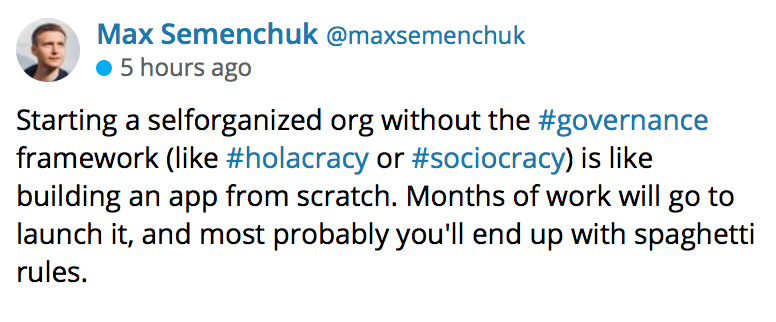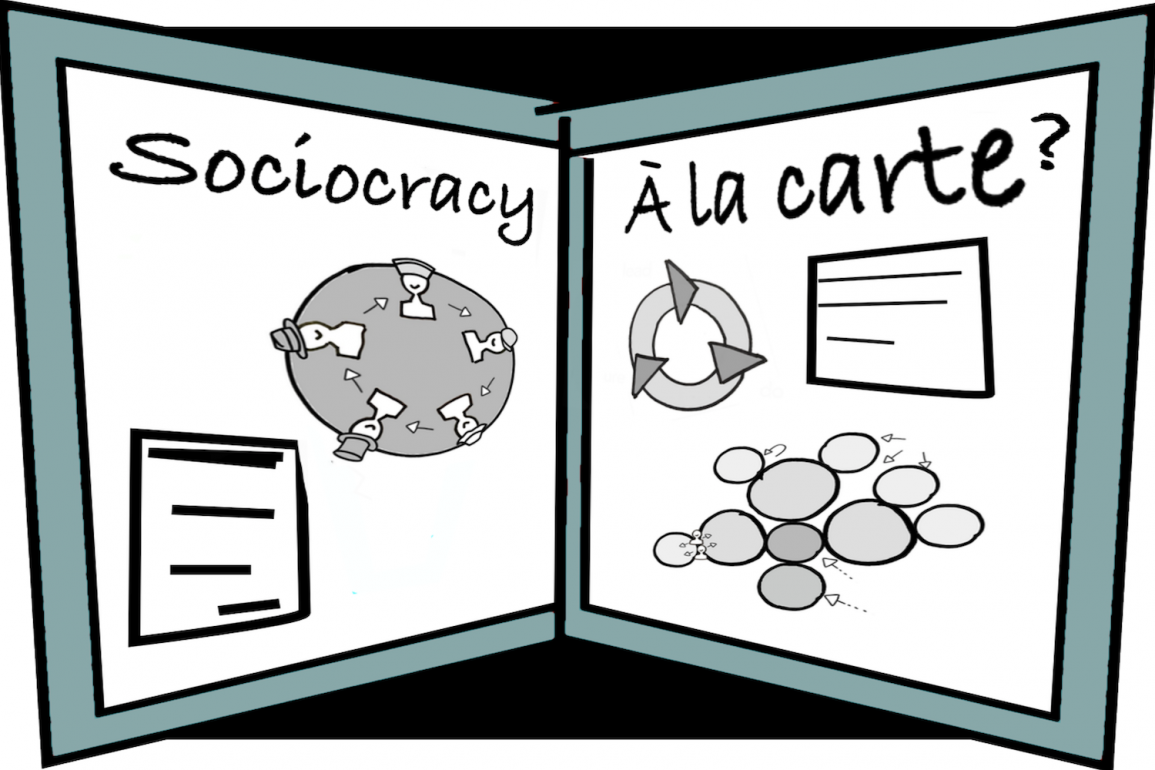By Ted J. Rau originally published on medium.com
Can one pick and choose from sociocracy?
This question is a hot topic as many people want to benefit from sociocratic tools but might be skeptical about adopting a “boxed” system. So, can one just pick and choose tools from sociocracy, or is it a package deal?
Instead of giving an answer — because I don’t think there is one — let me just highlight the considerations of the different positions. Can one pick and choose any tool from sociocracy?

“Yes, pick and choose! Because…”
a. You can do anything in consent-based systems.
Of course, you can use just some of the tools from sociocracy, for example, the meeting format, the circle structure or the consent decision making. Nothing keeps you from doing that.
It’s self governance, after all. If someone told you what to do, it would not be self-governance anymore. Decide for yourself. I’d only consider it sociocratic if you decided by consent but there is no requirement for any decision to be sociocratic.
b. Pick and choose so you can tailor the system to your organization.
There is no one-size-fits-all. Your organization has its own needs, desired and circumstances. It’s just logical that you would have to pick and choose what makes sense to you.
For example, my own organization (Sociocracy For All) with a few dozen members has two boards in different places, three General Circles-like circles, nested into a nicely tailored organizational structure just as we need it. This structure did not come out of a box but grew and evolved, and it keeps evolving. There is no way around picking and choosing, especially when you’re just starting out. An organic structure doesn’t fall ready-made from the sky.
c. Working with what you’ve got, any bit helps.
If you have a coercive work environment, any bit of employee voice might help. If you are part of a chaotic, informally run group, any bit of structure might help. That’s a strong reason to go ahead with any tool you can implement without needing to make the big leap towards a full implementation. The more the better. But doing a little if we can’t have all.
[Yet, I am a bit torn with this reasoning. I am torn because I have a hard time with sociocracy in bite-size pieces to calm the waters without actual change. Especially when I hear the phrase “I want people to feel heard so we’re doing rounds but not the whole thing.”
To me, “feeling heard” and “being heard” are worlds apart. So I personally struggle with band-aid size sociocracy when full-on surgery would be needed, especially when sociocratic tools are used to give an impression of equal voice in a system that is not willing to really share the powers.]

“No, don’t pick and choose. Do the whole thing.”
There are good reasons for those who say “Don’t mess with the system. Use it the way it was intended!” The three most convincing reasons for me are:
a. Why reinvent the wheel?
I am familiar with several organizations that came up with their own governance system and basically reinvented systems very similar to sociocracy. While that’s reaffirming, it also means that chances are, an organization that goes soul searching will spend months or years reinventing the wheel. Most organizations don’t have the resources to spend doing that, and besides, who knows how well that will come together. That’s what this tweet is about:

Reinventing a governance system is like someone taking a tricycle, replacing the back wheels with one central wheel, making the tires bigger. Why not just use a bicycle instead? Ask yourself, is there any value in having created it yourself, or do you just want to use it?
b. Patchwork is actually harder
One easily underestimated aspect of a patchwork system is that using only pieces of the whole is actually harder than using the whole thing. (I am not talking about implementation but about the use after implementation.)
That comes up for me when organizations ask me for advice and say “we want to use the meeting format but we don’t want small groups, we’ll just do it in the large group of 25 people.” No one can keep you from doing that but your 25 people need to be extremely civilized and cooperative to make a structured and effective meeting work with that group size. Sociocracy was not intended for that kind of use and, chances are, you will be disappointed.
To stay with the bicycle metaphor, that’s like asking “Can I use the skateboard with only two wheels?”. Of course you can. If you’re up for the challenge.
The pieces in sociocracy go very well together. Extremely well. I am still in awe seeing how they complement each other. Which leads me to my third consideration.
c. Know it first, then tweak it.
It’s usually not the established implementations that want to pick and choose but the organizations that are just starting out. And often, this is their first attempt at using tools from a system like sociocracy. They pick and choose and might not even know what each piece contributes to the whole.
For example, I know organizations that skip the part of “defined membership”. (FYI, sociocracy really depends on knowing who is in a decision-making group. It’s not closed, it’s just defined, i.e. we know who is a member of which circle at any given time.)
Defined membership might seem too formal at first, so the young group decides against it. They make any group open to anyone walking in the door. These groups struggle, and they might suffer for months before they are fed up and require defined membership. There are plenty more examples of rejecting a tool at first, struggling, and then introducing a similar solution later.
If you skip something, know what you’re skipping and why. No one would assemble a bike and throw out half of the parts whenever they’re not sure what the parts are actually for.

“That’s the wrong question.”
Besides all of this, asking whether you can pick sociocracy à la carte is basically the wrong question. Here is why.
a. There is no inherent value in “being sociocratic”.
Sociocracy is not a value to aspire to. Equivalence is and flow in effective collaboration is. No one cares how much sociocracy you do. Do whatever you need to do to accomplish that, no matter what that is.
Otherwise, it’s like asking “is a bike a good thing to have?” Depends on whether you’re going to use it. Do you want to go places? Sure, then it’s a good thing. Is it going to stay in your basement? Then probably not.
b. What’s sociocracy anyway?
Although there is a ‘canonical’ version of sociocracy, we use sociocracy in a wide definition. Anything that is consent-based and optimized for equal voice and effectiveness is sociocratic. The tools from the canonical version are the best we know right now but that doesn’t mean they are the only ones forever.
One could write a whole dissertation on what counts as sociocratic. Pick and choose from sociocracy for organizations and decision making but don’t forget all the other tools that make listening, ideas, dreaming, collaborating, bonding and managing tasks easier.
c. Find the tools that serve you.
The more useful question is this: what do you want from your governance system? If you want a free, tailor-able, mature and reliable governance system optimized for equal voice and effectiveness, then sociocracy is a good choice just like any other system that has had some time to be tried and tested. There is no one-size-fits-all. Familiarize yourself with the tools, what they do, and start building. Notice your gaps and address them.
Ted Rau is a trainer and consultant and works for Sociocracy For All. He is co-author of the sociocracy handbook Many Voices One Song.
Republished with permission of the author.
Featured Image by Medium.com




